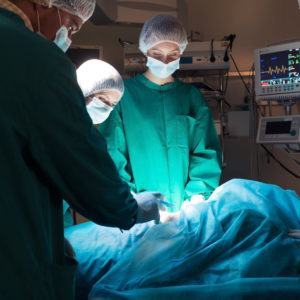Knee Implant Infection Lawsuit Filed Against Makers of Forced Air Warming Blanket

The 3M Company faces yet another product liability lawsuit, alleging that the design of their forced air warming blanket caused a knee implant infection after it was used during a Louisiana woman’s joint replacement surgeries.
The complaint (PDF) was filed by Holly Pack in the U.S. District Court for the Eastern District of Louisiana on February 15, indicating that the defective design of the 3M Bair Hugger warming system resulted in contaminants entering the surgical field when it was used during seven different knee procedures between December 2010 and May 2015.
The 3M Bair Hugger is a forced air warming blanket that is placed over a patient during hip or knee surgery, to help control body temperature. The device blows hot air onto the body during surgery, but has been linked to problems where it disrupts the operating room air flow, causing bacteria and contaminants from the floor and the device’s filtration system to entire the area around the open wound.

Learn More About
Bair Hugger warming blankets may be the cause of knee or hip surgery infections.
Learn More SEE IF YOU QUALIFY FOR COMPENSATIONThe device is found in most operating rooms nationwide, and has been the subject of a growing number of hip infection lawsuits and knee infection lawsuits filed in recent months, each raising nearly identical allegations.
“The Bair Hugger caused contaminants to be introduced into Plaintiff’s open surgical wound, which resulted in an infection, and require Plaintiff to undergo additional surgical procedures,” the lawsuit states. “Plaintiff now suffers and will continue to suffer from severe and permanent injuries as a result of the Bair Hugger-induced infection. Indeed, Plaintiff’s mobility is now impaired, making even the simple movement of walking a challenge.”
Although several experts indicate that safer alternative designs are available, Pack alleges that 3M Company has continued to defend the safety of their forced air warming blanket and provided false and misleading information to the medical community about the potential infection risk.
Pack underwent surgeries involving the warming blanket in December 2010, June, July, August and November of 2011, and in May 2012 and May 2015. However, the lawsuit indicates that the manufacturer knew of the problem of infections resulting from the use of forced air warming blankets since at least 2009, but withheld warnings.
The lawsuit presents claims for negligence, negligent misrepresentation, fraud and deceit, breach of warranty, strict product liability, and violating the Louisiana Products Liability Act, seeking both compensatory and punitive damages, which would be designed to punish the manufacturer for placing their desire for profits before consumer safety.
Amid the growing number of similar lawsuits filed over forced air warming blanket throughout the federal court system, the U.S. Judicial Panel on Multidistrict Litigation established coordinated pretrial proceedings for the cases in December, centralizing all federal 3M Bair Hugger cases before U.S. District Judge Joan Ericksen in the District of Minnesota, as part of an MDL, or Multi-District Litigation.
It is ultimately expected that several thousand complaints will be filed on behalf of individuals nationwide, as hip and knee implant infection lawyers continue to review and file claims for individuals diagnosed with MRSA, sepsis or other deep joint infections following use of the surgical warming blanket.
As part of any coordinated pretrial proceedings before Judge Ericksen, it is expected that a small group of cases will be prepared for early trial dates. Known as “bellwether” cases, the outcomes are designed to help the parties gauge how juries may respond to certain evidence and testimony that may be repeated throughout the litigation, potentially promoting settlement negotiations to resolve cases brought by individuals who have experienced problems.
1 Comments






KimMarch 11, 2016 at 1:29 pm
What about using this after a mastectomy? This is what my daughter in law had and she just had a double mastectomy. Any chance of infection we should be concerned with?